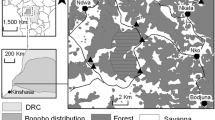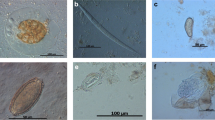Abstract
We report prevalences and eggs/protozoa per g (EPG; PPG) of helminths and protozoa in gorillas, chimpanzees, agile mangabeys, indigenous Ba'Aka and Bantu, and western researchers at a remote field site in the Central African Republic. We examined fecal samples for eggs, larvae, proglottids, cysts, amoeba, trophozoites, and flagellates. For helminths, strongylates were most prevalent, infecting 82–94% of nonhuman primates (NH) and 30–93% of human (H) groups, followed by ascaroids (14–88% NH; 0–15% H), and threadworms (0–22% NH; 0–29% H). For protozoa, Entamoeba histolytica (2–100% NH; 33–52% H) and trichomonads (11–88% NH; 0–54% H) were most prevalent. Among gorilla samples (n = 156) there were significant age/sex differences in EPG/PPG for strongylates, threadworms, Entamoeba histolytica, and trichomonads, with infants exhibiting the highest mean EPG/PPG for all parasites except trichomonads. Between group analyses revealed that the Ba'Aka had significantly higher mean EPG of strongylates, ascaroids and threadworms than all other primate groups, except the mangabeys. For Entamoeba histolytica, E. coli, Balantidium coli, and Iodamoeba butschlii, the agile mangabeys had significantly higher mean PPG than other groups; for trichomonads, the chimpanzees, and mangabeys had the highest mean PPG. Relative to other African ape sites, the gorillas and chimpanzees at Mondika appear to have high prevalences of intestinal parasites. This may be the result of the high proportion of swamp and seasonally flooded areas, which provide optimal viability for parasite eggs and ova. At Mondika, the significantly higher parasite levels of Ba'Aka probably result from more traditional methods of hygiene and lack of available medical treatment. All workers at research sites should be monitored and treated to minimize cross-transmission between humans and local fauna.
Similar content being viewed by others
REFERENCES
Adeyeba, O., and Dipeolu, O. (1984). A survey of gastrointestinal parasites in a local government area of south-west Nigeria. Int. J. Zoonoses 11(1): 105–110.
Appleton, C., Krecek, R., Verster, A., Bruorton, M., and Lawes, M. (1994). Gastro-intestinal parasites of the Samango monkey, Cercopithecus mitis, in Natal, South Africa. J. Med. Primatol. 23: 52–55.
Acha, P., and Szyfres, B. (1991). Zoonoses and Communicable Diseases Common to Man and Animals, Pan American Health Organization, Scientific Publication 503, Washington.
Ashford, R., Lawson, H., Butynski, T., and Reid, G. (1996). Patterns of intestinal parasitism in the mountain gorilla Gorilla gorilla in the Bwindi-Impenetrable Forest, Uganda. J. Zool. 239(Pt 3): 507–514.
Ashford, R., Reid, G., and Wrangham, R. (in press). Intestinal parasites of the chimpanzee (Pan troglodytes) in Kibale Forest, Uganda.
Boesch, C. (1996). Social grouping in Tai chimpanzees. In McGrew, W., Marchant, L., and Noshida, T. (eds.), Great Ape Societies, Cambridge University Press, Cambridge, pp. 101–113.
Bogitsch, B., and Cheng, T. (1990). Human Parasitiology, Saunders, Philadelphia.
Bowman, D., and Lynn, R. (1995). Georgis' Parasitology for Veterinarians, Saunders, Philadelphia.
Bundy, D. A. P. (1988). Population ecology of intestinal helminthal infections in human communities. Phil. Trans. R. Soc. Lond. (B)321: 405–420.
Burrows, R. (1972). Protozoa of the intestinal tract. In Fiennes, T.-W. (ed.), Pathology of Simian Primates, Karger, Basel.
Bush, A., Lafferty, K., Lotz, J., and Shostak, A. (1997). Parasitology meets ecology on its own terms: Margolis et al. revisited. J. Parasitol. 83(4): 575–583.
Cohen, S., Kaplan, J., Cunnick, J., Manuck, S., and Rabin, B. (1992). Chronic social stress, affiliation, and cellular immune response in nonhuman primates. Psy. Sci. 3: 301–304.
Couprie, B., Alilaire, C., Vivini, P., Daulouede, S., Tchamaha, R., Moyousomo, R., and Ripert, C. (1986). Epidemiological study of intestinal helminthiasis in 4 Barombi villages (Cameroon-South-West Province), Bull. Soc. Pathol. Filiales 79(5): 739–744.
Ekondzo, D., and Gautier-Hion, A. (1997- 1998). Elephant dung: A food source for the crested mangabey Cercocebus galeritus. African Primates 3: 41–42.
Fay, M. (1997). The Ecology, Social Organization, Populations, Habitat and History of the Western Lowland Gorilla (Gorilla gorilla gorilla), Doctoral Dissertation,Washington University, Saint Louis.
Flynn, R. (1973). Parasites of Laboratory Animals, Iowa State University Press, Ames.
Fossey, D. (1983). Gorillas in the Mist, Houghton Mifflin, Boston.
Goodall, J. (1986). The Chimpanzees of Gombe, Belknap Press, Cambridge.
Goodall, J. (1994). Postscript-Conservation and the future of chimpanzee and bonobo research in Africa. In Wrangham, R., McGrew, W., deWaal, F., and Heltne, P. (eds.), Chimpanzee Cultures, Harvard University Press, Cambridge, pp. 129–148.
Goussard, B., Collet, J., Garin, Y., Tutin, C., and Fernandez, M. (1983). The intestinal entodiniomorph ciliates of wild lowland gorillas (Gorilla gorilla gorilla) in Gabon,West Africa. J.Med. Primatol. 12: 239–249.
Hasegawa, H., Kano, T., and Mulavwa, M., (1983). A parasitological survey on the feces of pygmy chimpanzees, Pan paniscus, at Wamba, Zaire. Primates 24(3): 419–423.
Huffman, M. (1997). Current evidence for self-medication in primates: A multidisciplinary perspective. Yearb. Phys. Anthropol. 40: 171–200.
Huffman, M., and Wrangham, R. (1994). Diversity of medicinal plant use by chimpanzees in the wild. In Wrangham, R., McGrew, W., deWaal, F., and Heltne, P. (eds.), Chimpanzee Cultures, Harvard University Press, Cambridge, pp. 129–148.
Huffman, M., Page, J., Sukhdeo, M., Gotoh, S., Kalunde, M., Chandrasiri, T., and Towers, G. (1996). Leaf-swallowing by chimpanzees: A behavioral adaptation for the control of strongyle nematode infections. Int. J. Primatol. 17(4): 475–503.
Hungate, R. (1978). The rumen protozoa. In Kreier, J. (ed.), Parasitic Protozoa, Vol. II, Academic Press, New York.
Iwa, M. (1993). Handbook of African Medicinal Plants, CRC Press, Boca Raton.
Jackson, T., Sargeaunt, P., Visser, P., Gathiram, V., Suparsad, S., and Anderson, C. (1990). Entamoeba histolytica: Naturally occurring infections in baboons. Arch. Invest. Med. 21(1): 153–156.
Kaplan, J. (1986). Psychological stress and behavior in nonhuman primates. Comp. Prim. Biol. 2A: 455–492.
Kawabata, M., and Nishida, T. (1991). A preliminary note on the intestinal parasites of wild chimpanzees in the Mahale Mountains, Tanzania. Primates 32(2): 275–278.
Kightlinger, L., Seed, J., and Kightlinger, M. (1996). Ascaris lumbricoides aggregation in relation to child growth statis, delayed cutaneous hypersensitivity, and plant antihelminthic use in Madagascar. J. Parasitol. 82(1): 25–33.
Landsoud-Soukate, J., Tutin, C., and Fernandez, M. (1995). Intestinal parasites of sympatric gorillas and chimpanzees in the Lope Reserve, Gabon. Annls.Trop. Med. Parasitol. 89(1): 73–79.
Lilly, A. (1996). Behavioral and Biological Markers of Stress Susceptibility in Adolescent Female Rhesus Macaques Experiencing Separation From Natal Social Groups, PhD Dissertation, Rutgers University, New Brunswick, NJ.
Lilly, A., Mehlman, P., and Higley, J. (1999). Trait-like immunological and hematological measures in female rhesus across varied environmental conditions. Am. J. Primatol. 48: 197–223.
Marquart, W., and Demaree, R. (1985). Parasitology, Macmillan, New York.
Mascie-Taylor, C., Alam, M., Montanari, R., Karim, R., Ahmed, T., Karim, E., and Akhtar, S. (1999). A study of the cost effectiveness of selective health interventions for the control of intestinal parasites in rural Bangladesh. J. Parasitol. 85(1): 6–11.
McGrew, W., Tutin, C., and File, S. (1989). Intestinal parasites of free-living monkeys in far western Africa, Cercopithecus aethiop sabaeus and Erythrocebus patas patas. Afr. J. Ecol. 27: 261–262.
Melvin, D., and Brooke, M. (1982). Laboratory Procedures for the Diagnosis of Intestinal Parasites, 3rd ed. [Health and Human Services Publication No. (CDC) 82-8282].
Preslar, D. (1998). Human diseases, orangutans—Indonesia. Retrieved on November 29, 1998, from: proMed@usa.healthnet.org
Sokal, R., and Rohlf, F. J. (1995). Biometry, Freeman, New York.
Stuart, M., and Strier, K. (1995). Primates and parasites:Acase for a multidisciplinary approach. Int. J. Primatol. 16(4): 577–593.
Stuart, M., Strier, K., and Pierberg, S. (1993). Acoprological survey of parasites of wild muriquis, Brachyteles-Arachnoides, and brown howling monkeys, Alouatta-Fusca. J. Helmin. Soc. 60: 111–115.
Teare, J., and Loomis, M. (1982). Epizootic of balantidiasis in lowland gorillas. J. Am. Vet. Med.Assoc. 181(11): 1345–1347.
Tutin, C. (1996). Ranging and social structure of lowland gorillas in the Lope Reserve, Gabon. In McGrew, W., Marchant, L., and Noshida, T. (eds.), Great Ape Societies, Cambridge University Press, Cambridge, pp. 58–70.
Tutin, C., and Fernandez, M. (1993). Compositions of the diets of chimpanzees and comparisons with that of sympatric lowland gorillas in the Lope Reserve, Gabon. Am. J. Primatol. 30: 195–211.
Tutin, C., Parnell, R., White, L., and Fernandez, M. (1995). Nest building by lowland gorillas in the Lope Reserve, Gabon: Environmental influences and implications for censusing. Int. J. Primatol. 16(1): 53–76.
Wallis, J., and Lee, D. (1999). Primate Conservation: The prevention of disease transmission. Int. J. Primatol. 20(6): 803–826.
Watkins, W., and Pollit, E. (1997). Stupidity or worms: Do intestinal worms impair mental performance? Psy. Bull. 121(2): 171–191.
Williamson, E., Tutin, C., Rogers, M., and Fernandez, M. (1990). Composition of the diet of lowland gorillas at Lope in Gabon. Am. J. Primatol. 21: 265–277.
Zeibig, E. (1997). Clinical Parasitology, Saunders, Philadelphia.
World Health Organization. (1998). Intestinal Parasites Disease Situation. Available from: http://www.who.org CTD
Author information
Authors and Affiliations
Rights and permissions
About this article
Cite this article
Lilly, A.A., Mehlman, P.T. & Doran, D. Intestinal Parasites in Gorillas, Chimpanzees, and Humans at Mondika Research Site, Dzanga-Ndoki National Park, Central African Republic. International Journal of Primatology 23, 555–573 (2002). https://doi.org/10.1023/A:1014969617036
Issue Date:
DOI: https://doi.org/10.1023/A:1014969617036




